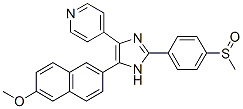All AbMole products are for research use only, cannot be used for human consumption.

Tie2 kinase inhibitor is a potent, reversible, and ATP-binding site-targeting Tie2 inhibitor with an IC50 of 250 nM. Tie2 kinase inhibitor has a remarkable selectivity for Tie2 over p38 (IC50 = 50 μM) and a >10-fold selectivity over VEGFR2, VEGFR3 and PDGFR1β. Tie2 kinase inhibitor showed efficacy in an in vivo model of angiogenesis and a MOPC-315 plasmacytoma xenograft model. In addition to its activity as an inhibitor of Tie2 kinase, Tie2 kinase inhibitor also shows modest activity against a variety of cultured mammalian cells.
| Cell Experiment | |
|---|---|
| Cell lines | Human aortic endothelial cells (HAECs) |
| Preparation method | Treatment of HAECs with Ang1 and Tie2 inhibitors Before use, Ang1 was preincubated with anti-poly-histidine antibody (R&D Systems, Minneapolis, MN) to form dimers prior to the treatment of HAECs. Equal numbers of HAECs were grown to confluent monolayer and starved with serum-free EBM medium for 6 h. HAECs were pretreated with Tie2 inhibitors or the carrier DMSO (final concentration at 0.5%) for 1 h followed by the stimulation with dimerized Ang1 for 10 min at 37 C. The same amount of protein was loaded into each well of SDS–PAGE. |
| Concentrations | 0, 0.1, 0.3, 1µM |
| Incubation time | 1 h |
| Animal Experiment | |
|---|---|
| Animal models | Rat model of choroidal neovascularization (CNV) |
| Formulation | PBS |
| Dosages | 10 µg/µl |
| Administration | injection |
| Molecular Weight | 439.53 |
| Formula | C26H21N3O2S |
| CAS Number | 948557-43-5 |
| Solubility (25°C) | DMSO 17 mg/mL |
| Storage |
Powder -20°C 3 years ; 4°C 2 years In solvent -80°C 6 months ; -20°C 1 month |
[1] Semones M, et al. Bioorg Med Chem Lett. Pyridinylimidazole inhibitors of Tie2 kinase.
[2] Zhou BN, et al. Org Lett. The first naturally occurring Tie2 kinase inhibitor.
| Related Products |
|---|
| Diethylenetriaminepentaacetic dianhydride
Diethylenetriaminepentaacetic dianhydride (DTPA anhydride) is a bifunctional chelator whose anhydride can react with amino groups in proteins (such as lysine residues) to form stable amide bonds. Diethylenetriaminepentaacetic dianhydride (DTPA anhydride) can also bind to radionuclides to synthesize radionuclide-labeled drug conjugates (RDCs). |
| 3-Phenylthiophene
3-Phenylthiophene is a biochemical material that can be used in scientific research. 3-Phenylthiophene is a conducting polymer precursor. |
| DSPE-PEG-FA
DSPE-PEG2K-FA is a PEG derivative containing folic acid. DSPE-PEG2K-FA has a targeting effect and can bind to folic acid receptors in cancer cells. DSPE-PEG2K-FA forms micelles/lipid bilayers and can be used in research on targeted drug delivery systems. |
| Lifastuzumab
Lifastuzumab is a humanized anti-NaPi2b IgG1 monoclonal antibody. |
| GPVI antagonist 1
GPVI antagonist 1 is a glycoprotein VI (GPVI) platelet receptor antagonist. GPVI antagonist 1 inhibits collagen-induced platelet aggregation with an IC50 of 25.3 μM. |
All AbMole products are for research use only, cannot be used for human consumption or veterinary use. We do not provide products or services to individuals. Please comply with the intended use and do not use AbMole products for any other purpose.


Products are for research use only. Not for human use. We do not sell to patients.
© Copyright 2010-2024 AbMole BioScience. All Rights Reserved.
